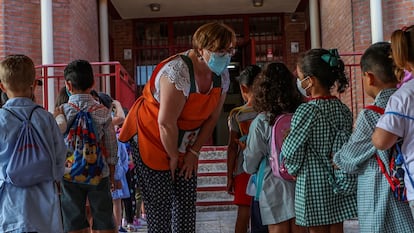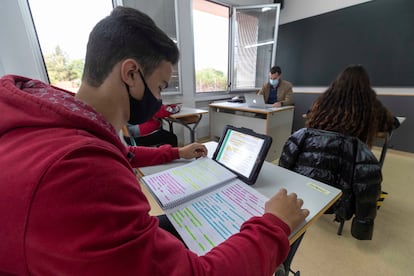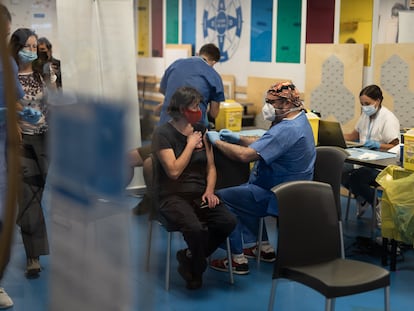Falling Covid cases in Spain’s schools lead experts to believe herd immunity is near
A month into the academic year, infection rates remain low even among unvaccinated children

Fears that were rife in Spain a month ago ahead of the return to school of 5.2 million students under the age of 12 have now made way for optimism. A possible rise in infections among the only group of the population that has not been vaccinated against Covid-19 has not come to pass, and experts are starting to consider that the levels of protection reached – nearly 80% of the Spanish population has been fully inoculated – have brought Spain to a situation that is nearing something resembling herd immunity. While the total eradication of the virus is not expected, the experts consider that the moment when students aged over six in elementary schools will no longer have to wear face masks is not far away.
“We are in the best of the scenarios that we could have expected a month ago,” explains Quique Bassat, an epidemiologist and researcher at the ISGlobal institute in Barcelona. “Community transmission has fallen a lot and very fast, and this, together with the protection measures that have been maintained in schools, has been sufficient even with a variant that’s as contagious as delta,” he explains, in reference to the strain that first was detected in India and has now become predominant.
Jesús Rodríguez Baño, the head of infectious diseases at the Virgen de la Macarena Hospital in Seville, shares this view. “If we have to look for an explanation for why the epidemiological situation is improving in a sustained manner, and is also doing so among those who are unvaccinated, given that the delta variant is circulating and we are gradually returning to normal, the only plausible one is that something similar to that concept of herd immunity is already working,” he says.

The daily report from the Spanish Health Ministry provides the data that support these hopes, only tempered by the “necessary precautions that must be maintained when faced with a virus about which we still don’t know things like how long immunity lasts,” as Rodríguez Baño explains. The 14-day cumulative incidence was, in Thursday’s ministry report, at 40.5 cases per 100,000 inhabitants, a third of that registered a month ago. This trend has also been seen among the under-12s, for whom the incidence has fallen from 150 to 60 this month. The fall has been even more abrupt – from 154 cases to barely 30 – among the 12-19 age group, 80% of whom have already been fully vaccinated against Covid-19.
The rest of the indicators being used to measure the pandemic in Spain are following the same pattern. There are currently 1,854 Covid-19 patients in Spanish hospitals, compared to 4,600 a month ago. The number of people in intensive care units (ICUs) is 454, compared to nearly 1,200 a month ago. And the number of deaths in the last seven days has fallen from 200 to 87, although this number includes people who became infected but whose main cause of death is due to other conditions.
If these data are compared to a year ago, when the second wave began to take shape, the differences are stark. The incidence then was in excess of 250 cases per 100,000 inhabitants, there were 11,300 Covid-19 patients in hospital and 1,600 ICU patients. In Catalonia, for example, a year ago there were 1,500 classes confined – now there are just 100.
“We are entering a new stage where we must accept that Covid is just another infectious disease,” explains Rodríguez Baño. “Just like there are other diseases whose impact we fight to limit, like the flu, without this stopping us from living a reasonably normal life, now we have to learn as a society to live with the coronavirus.”
In the equation that links SARS-CoV-2 with schools, there are three consecutive processes, the experts explain. The first is the entrance of the virus in schools, something that depends on the circulation of the pathogen in the community. The second are the infections that take place in classrooms, which during the entire pandemic have been kept low in Spain, thanks to the combination of the protection measures in place – including masks and bubble groups, among others – and the fact that the virus is less contagious among young children. And finally, there is the possibility that schools are places where outbreaks are common, something that has not happened during the pandemic.
“With the currently low incidence, a lot fewer cases are coming in,” Bassat explains. “Each case is still producing very few infections. And if there are infections, like with relatives of children, they are mostly vaccinated, and the chains [of infection] are broken very quickly. The vaccines do not stop infections, but they do greatly reduce them and the symptoms are nearly always mild. All of this has a multiplying effect that explains the good current epidemiological situation.”
We are in the best of the scenarios that we could have expected a month agoQuique Bassat, epidemiologist at ISGlobal Barcelona
The experts point to the fact that, thanks to the high vaccine coverage achieved, the risk of mass outbreaks taking place has been reduced to the minimum – a phenomenon that has been so significant during previous waves. “The most-likely scenario in the immediate future is that there will be no big new waves. What might be seen are local increases in the incidence but these will not spread, although there will still be some elements of uncertainty such as the appearance of new variants,” explains Clara Prats, a Computational Biology researcher at the Catalan Polytechnic University (UPC).
Bassat believes that the delta variant has not, in the end, been as problematic in the classroom as was feared. “Our studies about the alpha variant showed that the R number [the average number of infections that stem from one coronavirus case] was around 0.6 to 0.7 in some age groups for children. Now we can expect that they will rise more with delta, but the preliminary data show us that this has not happened, or not in any relevant way.”
The improved epidemiological situation and the positive data in the classrooms has once again resuscitated the debate as to whether children over the age of six should still have to wear masks in schools. The country’s regions – which are in charge of their education and healthcare systems, as well as Covid measures and the vaccination program – are still calling for caution given the need to consolidate the trend, and given the fears that other respiratory viruses could enter the scene.
In Valencia, the regional education chief, Vicent Marzà, explained in the regional assembly that masks will remain obligatory while health experts say that they are needed. Marzà also explained that the region had returned to 100% face-to-face teaching, as is the case in the rest of Spain, and that schools are in a “completely normal” situation, María Fabra reports.
In Catalonia, meanwhile, the regional health chief, Josep Maria Argimon, said this week that the use of masks will remain during the fall and winter because “it is the season of coronavirus,” and he called for “caution” in the coming months given the risk that the coronavirus and flu could combine. Despite this, Argimon announced that schools would be the first to scrap the use of masks indoors as soon as this was possible.
“We want to be prudent, because keeping schools a safe space has been an achievement and we want to maintain this,” Bassat argues. “We have only had good news in the last month.” The expert points to the fact that the question of whether masks should still be necessary in indoor spaces is yet to be resolved, although he does believe it is positive that children will be the first to stop using them. “They can be the sentries and the ones who tell us whether masks can be scrapped indoors,” he explains. “If an unvaccinated population can do so without a risk of outbreaks, that would be the best news.”
Rodríguez Baño points to “northern Europe,” where there “are already countries that have removed masks indoors and they have lower vaccination rates, meaning that we can probably soon start to think about returning to complete normality without masks, and that’s what we have to consider.”
Tu suscripción se está usando en otro dispositivo
¿Quieres añadir otro usuario a tu suscripción?
Si continúas leyendo en este dispositivo, no se podrá leer en el otro.
FlechaTu suscripción se está usando en otro dispositivo y solo puedes acceder a EL PAÍS desde un dispositivo a la vez.
Si quieres compartir tu cuenta, cambia tu suscripción a la modalidad Premium, así podrás añadir otro usuario. Cada uno accederá con su propia cuenta de email, lo que os permitirá personalizar vuestra experiencia en EL PAÍS.
¿Tienes una suscripción de empresa? Accede aquí para contratar más cuentas.
En el caso de no saber quién está usando tu cuenta, te recomendamos cambiar tu contraseña aquí.
Si decides continuar compartiendo tu cuenta, este mensaje se mostrará en tu dispositivo y en el de la otra persona que está usando tu cuenta de forma indefinida, afectando a tu experiencia de lectura. Puedes consultar aquí los términos y condiciones de la suscripción digital.
More information
Últimas noticias
Maduro pleads not guilty before the federal court in New York: ‘I am still the president of Venezuela’
A new test can detect Alzheimer’s from a finger prick
UN team enters Sudanese city of El Fasher after paramilitary massacre: ‘It’s like a ghost town’
A recipe for resistance: Indigenous peoples politicize their struggles from the kitchen
Most viewed
- Gilles Lipovetsky: ‘If you want to live better and fall in love, take Prozac, don’t look to philosophy’
- Alain Aspect, Nobel laureate in physics: ‘Einstein was so smart that he would have had to recognize quantum entanglement’
- Alvin Hellerstein, a 92-year-old judge appointed by Bill Clinton, to preside over Maduro’s trial in New York
- Why oil has been at the center of Venezuela-US conflicts for decades
- Maduro’s downfall puts China’s relationship with Venezuela to the test











































